DEATH CAMP SHOCKS DISCOVERERS
Ohrdruf, Central Germany · April 4, 1945
Over the first three weeks of April 1945, during the brutal terminal phase of the Third Reich, Allied armies discovered more than one hundred concentration camps, including Buchenwald, Nordhausen, Flossenbuerg, and Bergen-Belsen. On this date in 1945 soldiers of Gen. George S. Patton’s Fourth Armored Division unexpectedly came upon the ghastly scene of the mostly deserted Ohrdruf forced labor camp, Stalag Nord Ohrdruf, a Buchenwald subcamp.
The original mission of Patton’s men had been to search south of Gotha in Thuringia (Thueringen), South-Central Germany, for a secret, last-ditch underground bunker that reputedly was to house a new Fuehrer headquarters for Hitler and his staff. A report from one of the camp liberators reached Generals Dwight D. Eisenhower, Omar Bradley, and Patton as they visited a nearby salt mine where the Nazis had stored $250 million in gold bars, currency, and art treasures.
After lunch on April 12 the generals visited the Ohrdruf camp, the first Nazi prison camp U.S. servicemen had discovered on German soil and the first they liberated while it still had inmates living inside its barracks. Dressed in rags, the survivors were practically skin and bones, emaciated from the effects of starvation and disease. Week-old corpses of prisoners in the roll-call square and elsewhere in the camp caused battle-hardened Patton to lose his lunch out of the sight of news cameras. It also caused him to order townspeople from Ohrdruf, which lay a mile away, to tour the “horror camp” and see for themselves the crimes committed by their compatriots. Patton’s order was repeated at Buchenwald, Dachau, and other camps liberated by American soldiers and by at least one Soviet commanding officer who directed German inhabitants of villages surrounding the notorious women’s concentration camp at Ravensbrueck north of Berlin to tour that facility.
A few weeks later Eisenhower established a POW camp in nearby Gotha, where he had made his headquarters, to house SS officers, camp guards and doctors, and prisoner-functionaries who had served at Nazi labor and death camps. Many were sentenced by Allied military tribunals to long prison terms or death based on the evidence collected during Allied walkthroughs.
Liberated Nazi Forced Labor Camp at Ohrdruf, Central Germany, Visited by U.S. Generals and Nearby Townspeople
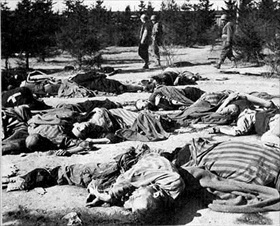 | 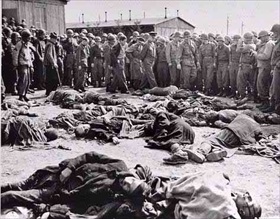 |
Left: Corpses at Ohrdruf camp gate. Survivors testified that the POWs had been shot by the SS on April 2 because they had run out of trucks for evacuating sick prisoners. Many of the dead had been so emaciated and malnourished that the bullet wounds in their skulls had not even bled.
![]()
Right: Twenty-one generals and their staffs toured Ohrdruf on April 12, 1945. Some members of the entourage were unable to go through with the ordeal. On April 19, 1945, Eisenhower cabled Washington to quickly dispatch journalists and members of Congress to Ohrdruf to dispel any allegations that the stories of Nazi brutality were merely propaganda. American newsreels of Ohrdruf called the camp a “murder mill.” (See YouTube video below.)
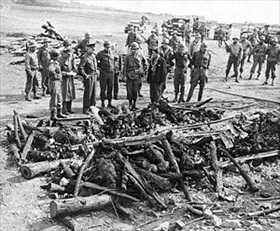 | 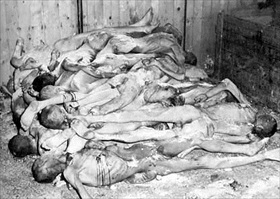 |
Left: Generals Eisenhower, Bradley, Patton, and Manton Eddy, among others, view the charred remains of prisoners who were burned upon a section of railroad track during the evacuation of Ohrdruf by retreating camp officers, guards, and staff. Patton wrote that the scene reminded him of “some giant cannibalistic barbecue.” Remembering their walk through the camp, Bradley remarked how “the smell of death overwhelmed us.” When a camp guard showed Eisenhower how some starved prisoners had torn out the entrails of the dead for food, the general’s face, Bradley wrote, “whitened into a mask.” Bradley was struck dumb, “too revolted to speak.”
![]()
Right: Bodies of forty starved prisoners in a shed at Ohrdruf were layered with lime to mitigate the smell. Patton described the shed as “the most appalling sight imaginable.” When the shed was packed full (about 200 bodies), its contents would be taken to a pit a mile from the camp and buried.
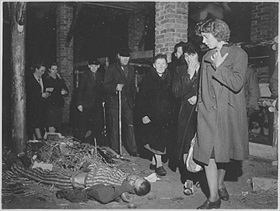 | 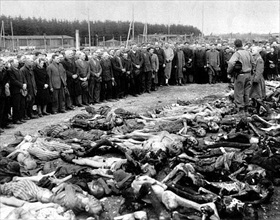 |
Left: Soon after visiting Ohrdruf, Gen. Eisenhower ordered every nearby unit not on the front lines to tour Ohrdruf. Gen. Walton Walker ordered Ohrdruf’s mayor and his wife brought to the camp to see the display of corpses. After seeing the horror, the couple went home and killed themselves.
![]()
Right: American soldiers forcibly brought Ohrdruf townspeople to the camp to exhume the bodies in the mass grave and bury them again in individual graves.
“Liberators and Survivors: The First Moments,” Produced by The International School for Holocaust Studies
![]()

 History buffs, there is good news! The Daily Chronicles of World War II is now available as an ebook for $4.99 on Amazon.com. Containing a year’s worth of dated entries from this website, the ebook brings the story of this tumultuous era to life in a compelling, authoritative, and succinct manner. Featuring inventive navigation aids, the ebook enables readers to instantly move forward or backward by month and date to different dated entries. Simple and elegant! Click
History buffs, there is good news! The Daily Chronicles of World War II is now available as an ebook for $4.99 on Amazon.com. Containing a year’s worth of dated entries from this website, the ebook brings the story of this tumultuous era to life in a compelling, authoritative, and succinct manner. Featuring inventive navigation aids, the ebook enables readers to instantly move forward or backward by month and date to different dated entries. Simple and elegant! Click 











